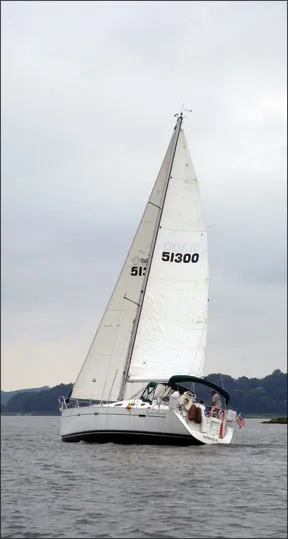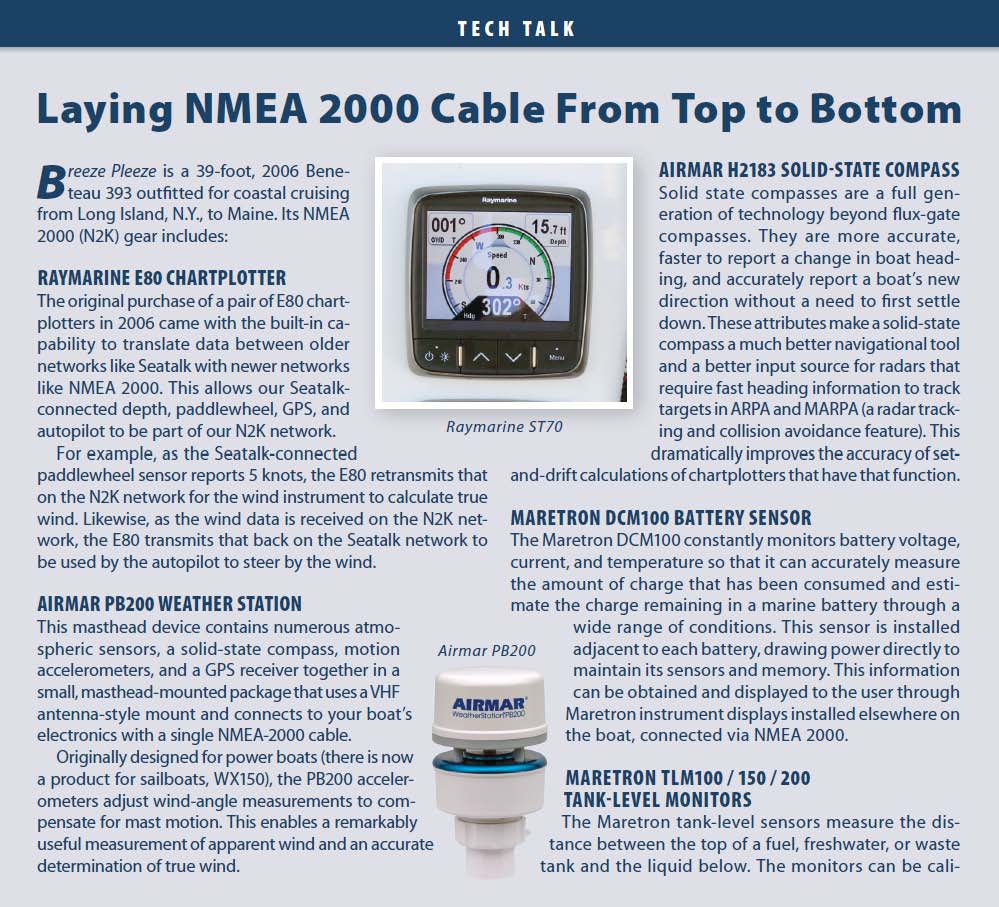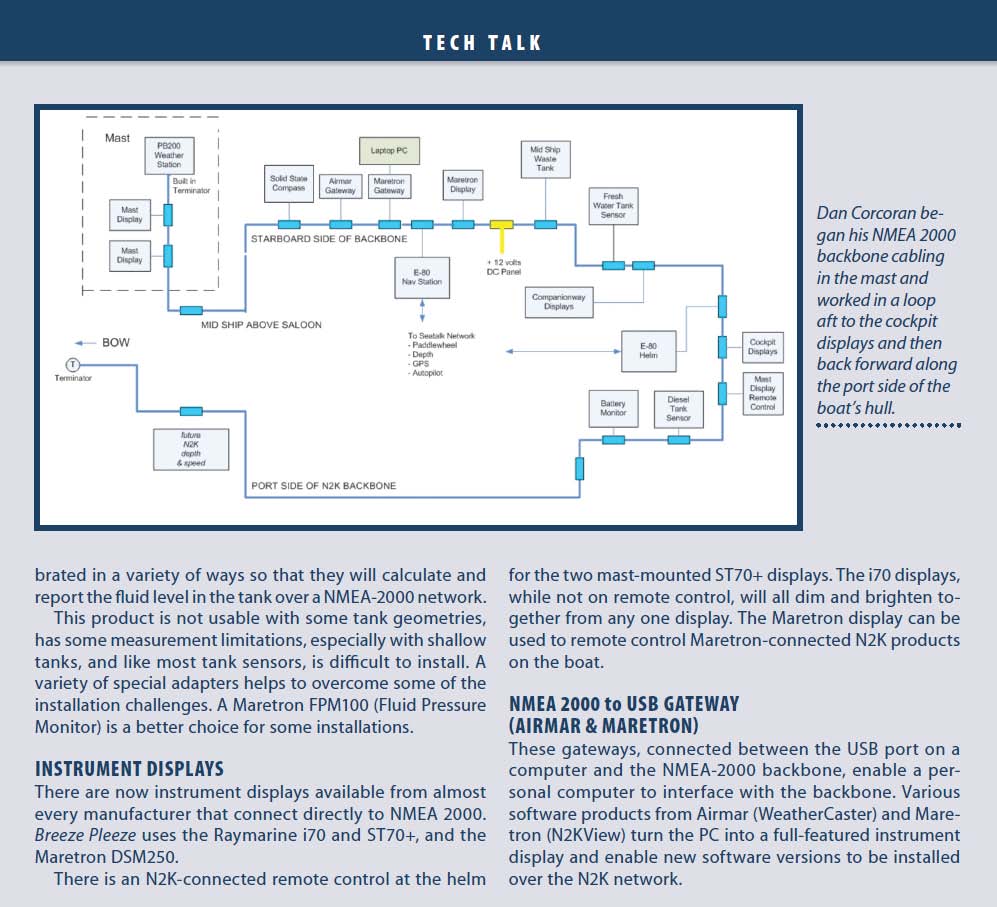A sailboat is no place for unnecessary complexity, which was the direction we were headed on my Beneteau 39, Breeze Pleeze, when it came to how data was passed between the various marine electronics in her belly.

Photo courtesy of Dan Corcoran
The worst offender was a spaghetti network of point-to-point wiring that utilized the familiar National Marine Electronics Association (NMEA) 0183 standard. A few years ago, I embarked on the gradual replacement of NMEA 0183 wiring and components with the new standard, NMEA 2000.
On Breeze Pleeze, NMEA 0183 was used to connect an Icom VHF radio, Raymarine autopilot, two classic Raymarine E-series multi-function displays, an Airmar PB200 weather station, and a Dell laptop. This enabled me to combine Airmar PB200 masthead weather-sensor data with Raymarine sensor data on my E-series displays, allowing me to take advantage of all sorts of strong technology.
The setup provided fast compass-heading data from the autopilot to the E-series in support of MARPA, a radar tracking and collision-avoidance feature. It enabled the Rescue 21 functionality on the Icom VHF, which requires a GPS position; allowed VHF-DSC positions to be received and displayed on the E-series; and allowed the laptop to capture data.
However, the connections between all this gear had a dozen or more points that could fail, making it difficult to isolate problems. Instruments would briefly display zero depth, and they couldnt handle all the cool data coming from the PB200 weather station, requiring me to disable the barometer and masthead air temperature gauge. And, there was no hope of supporting an additional component, like an AIS transceiver, without major rewiring.
By comparison, the other two networks on the boat, Raymarines SeaTalk and Ethernet, were ready and willing to accept new devices. However, neither provide for the easy mixing and matching of components from other vendors, as was possible using 0183.
Even though it would mean a fourth network on my sailboat, I became intrigued with the prospect of moving toward NMEA 2000, often known by the shorthand N2K, especially since my Raymarine chartplotters, i70 display, and Airmar PB200 weather station already supported the standard.
In a nutshell, NMEA 2000 uses a single wire backbone, run from one end of your boat to the other. Sensors and displays are attached using T-shaped connectors. The backbone provides power to the devices and acts as a relay for data. The system allows the installer to mix and match marine electronics from vendors that support the NMEA 2000 standard.
PLANNING THE SYSTEM
The first challenge was creating a plan and a diagram of how best to route the backbone wire to all the electronics from stem to stern and up the mast. The wiring between the backbone and the devices also needed to be kept relatively short to meet some length restrictions in the standard.
A free PC software product from Maretron called N2K Builder was ideal for laying out the network, entering in cable lengths, and generating a pass/fail result. To make the best use of existing conduit, I started the backbone at the mast top, came down to the mast base, and made a circular route around the inside of the hull.
The second challenge was to select the best brand and style of NMEA 2000 cabling to use. Although each manufacturer follows a data standard, the physical cable and its connectors vary between manufacturers. I chose the Maretron mid-size cabling. I liked the larger diameter of its internal conductors, the range of pre-fabricated cables to connect with devices, and the availability of male and female connectors from which I could create my own custom cable lengths.
The third challenge was thinking through the options for powering the backbone. The two most straightforward choices are to power the backbone at the location closest to the DC panel-to minimize voltage drops-or to choose a point in the middle of the backbone, where the power requirements on each side are about equal. Again, Maretrons N2K Builder came in handy. I input all the devices I intended to connect, including some I planned to purchase, and received a pass/fail answer regarding the suitability of each choice.
With only a few NMEA 2000 devices on hand to start, building the entire network wasnt going to make sense, but the planning helped me decide where the power supply would tap into the backbone. I decided to build a small network, putting the power tap near the DC panel, and I did the installation myself.
Using pre-fabricated cables and connectors, I started with the power connection for my Airmar H2183 solid-state compass and Raymarine E-series chartplotter. Two fuses protected against over-current, one on each side of the power tap. From there, two T connectors were added, and drop cables were run to the compass and the display. Finally, a 2-inch-long terminator was attached to each of the two ends of the backbone. Cabling and connectors for the entire system cost roughly $190 and required less than an hour to assemble.
I switched on the E-series, and voila! The compass heading appeared immediately at start-up. Ive since added more devices to the network, and each time, the result has been the same: It works right away.
The system has provided other benefits. Since the connectors and backbone wiring are less fragile, I feel more confident that adding devices to the network wont add potential for cable or connection failures.
The data rate on the backbone is also much higher, 250,000 bits per second versus 4,800 bits for NMEA 0183. This allowed me to activate the barometric pressure and air-temperature measurements on the weather station.
Component failures are also far less problematic. Unlike NMEA 0183, not all the devices on a NMEA 2000 backbone need to be powered and functioning for the whole thing to work. As with most modern networks, the system devices to be easily removed and repaired if they fail-and the failure of a device generally wont prevent data from flowing between other devices.
And, of course, I have been able to add to the network. Since my original foray, I have expanded the backbone up the mast and around the boat, spending another $500 or so on cabling and parts.
The N2K network now includes 18 devices: two Raymarine E80 chartplotters, two ST70+ color displays, five i70 color displays, one Airmar PB200 weather station, an Airmar H2183 compass, a Maretron color display, a Maretron DCM-100 battery monitor, three Maretron ultrasonic tank sensors, and both a Maretron and an Airmar NMEA 2000-to-USB gateway.
Was it all worthwhile? Absolutely. Despite the addition of four sensors, three displays, and a couple of years of age on existing electronics, the time I spend troubleshooting electronics each year has been cut in half. And that means more quality time on the water.
* * *
Dan, wife Yunji, and daughter Casey Corcoran initially equipped their 2006 Beneteau 393 for coastal cruising in the Northeast. The N2K-updated Breeze Please has since won several regional non-spinnaker cups.





































